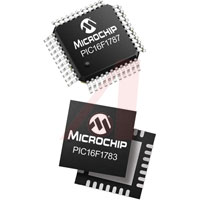PIC16F1783-I/SP產(chǎn)品概述
Summary:
Analog design is difficult and consumes precious development time. Microchip’s intelligent PIC® MCUs integrate analog functions such as high-performance
Analog-to-Digital Converters (ADCs), Digital-to-Analog Converters (DACs) and operational amplifiers (op amps) providing simple-to-use interfaces that ease analog
design. This single-chip solution enables reduced system noise and provides higher throughput, while dramatically reducing design time and cost.
The analog functions of the PIC® MCUs scale from the low-cost and low-power PIC16 and PIC24 families to dsPIC® Digital Signal Controllers for the highest
performance digital control.
Applications:
This flexibility and efficiency benefit multiple applications:
Environmental quality sensors
?Portable medical equipment (glucose meters, portable ECGs, pulse oximeters, blood pressure meters)
Industrial equipment (gas sensors, handheld multi-meters, lab instrumentation, e-meters, sensor arrays)
Power conversion
Efficient motor control
Lighting
Power measurement and monitoring
Energy harvesting equipment
Solar inverters
Microchip's Intelligent Analog solutions reduce component count enabling smaller, more cost-effective boards and simplified, higher-performance designs. In addition, designers benefit from increased analog topology flexibility utilizing the MCU’s programmable analog interconnects.
Analog Building Blocks
Analog-to-Digital Conversion
Flexible connections between ADC and other on-chip analog
Including precision 16-bit S? ADC and high-speed 10 Msps 12-bit ADC
Voltage References
Programmable internal reference source for on-chip analog modules
Buffered reference outputs available
Independent configurations for various low-power modes for flexible power management
Charge Time Measurement Unit
Constant current source for measurement of capacitance, inductance, resistance, temperature or time
Capacitive touch sensing, up to 50 channels
Time measurement down to 100 ps resolution
Zero Cross Detect
Senses when high-voltage AC crosses through ground
Minimizes EMI caused by switching transients
Simplifies TRIAC control
Slope Compensation
Improves Peak Current Mode DC/DC conversion
Stabilizes switching frequency for duty cycles over 50%
Digital-to-Analog Conversion
Multiple on-board DACs with various resolution
Flexible interconnects enable “on the fly” reference setting
Op Amp
On-chip signal conditioning
Faster response time, eliminates noise concerns
High Speed Comparators
Dual mode for low-power/high-speed options
Off load processing to simple hardware
Analog Interconnect Switch Matrix
Allows for connecting analog blocks within the chip
Reduces the number of connections to I/O pins
Increases throughput and reduces noise


 Datasheet
Datasheet